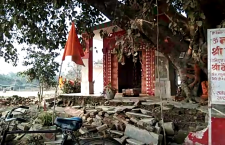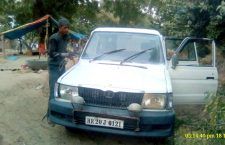The Primary Health Centre in the small village of Chirai, Varanasi has a serious simian problem. Monkeys have settled down on the roofs and are terrorizing its occupants and nearby residents.
“Oh, they are a big problem. If you’re walking by with anything to eat or drink they snatch it out of your hands. Really, anything that is in your hand they will take,” said Rajkumar, a shopkeeper in the area. These animals’ monkeying around is more serious than just a few lost plates of food. “They’re very strong and smart. From shopkeepers to patients, everyone is sick of them. They even bother the newborns in the delivery wing!” he added, exasperated.“If we leave the door open in the ward they monkeys come inside,” explained Laalmani as she double-checked the shut door in what functions as the delivery and emergency ward of the PHC, “They’ve already come inside three, four times.”
The big fear remains baby snatching. “It will be terrible if a monkey comes in and snatches a baby,” said ASHA worker Reena, “They’ve already bitten a few people in this block, they’ve had to get injections.”
But a primate is just another monkey on the back as far as rural healthcare in the country’s most populous state is concerned.
The National Rural Health Mission’s structured approach to rural healthcare is in three tiers—at the bottom on the gram panchayat level are sub-centres, followed by PHCs for a cluster of gram panchayats, and then Community Health Centres that are supposed to be referrals for every four PHCs. Health workers like ASHA and ANMs form the base of this pyramid, but the PHC is often the first point of contact with medical care for many in the rural population. They are supposed to be well-equipped to deal with in- and out-patient care, with an ambulance service, functional operational theatre and labour room.The on-ground reality does not reflect these aspirations.
In U.P., the most populous state in the country, with adecennial rural population growth rate of 28.82%, there areonly 3621 functioning PHCs—which is a shortfall of 30% , because the requirement in the state is of 5194 PHCs. Only 170 of all of these PHCs function as per IPHS norms; 213 don’t even half electricity.The CHCs, sub-centres and sub-divisional hospitals don’t fare much better.
One of the central goals of the NRHM was to reduce infant and maternal mortality rates across the country. And although they have significantly decreased in the last decade, the numbers in UP are still precarious. The infant mortality in rural UP in 2016 was 46, the second highest in the country. Maternal mortality rates, as configured out of 1 lakh live births, was 285, according to 2011-2013 data—again, one of the highest in the country. Only 5.9% of mothers in UP have received full ante-natal care. Half of UP’s women and children have anemia.
For a state with 30% of its population living below the poverty line, the governmental provisions of healthcare are often the only option. And yet, there is markedly lower service utilization for UP when compared to the national average—2.5 times less in the case of out-patient department visits, and roughly half of in-patient department visits—which is an indicting indication of the poor quality of services. The Gorakhpur hospital tragedy is all but a clear reminder of the steep cost of doctor’s negligence and infrastructural failure in public hospitals.
The widely discussed Ayushman Bharat Yojana launched in September this year promised two things—health protection of a cover of Rs. 5 lakhs per poor family per year, and the upgradation of the existing 1.5 lakh sub-centres into Health and Wellness Centres (HWCs) for ensuring primary – especially non-communicable diseases (NCDs) – care. The allocation for this is Rs1,200 crores. But assuming this is spent on revamping just half the target, it amounts to Rs1.6 lakh per centre—which seems insufficient, to say the least. Meanwhile, there has been a 2.1 percent decline in the allocation for the National Health Mission–a national health programme that funds infrastructure for primary healthcare–from Rs 31,292 crores in 2017-18 (revised estimates) to Rs 30,634 crores (2018-2019 budget estimate).
In a country where 3.9 crore people are pushed into poverty every year because of inadequate public health infrastructure and healthcare expenses, monkeys may seem like the laughable final straw—but this too is a problem the locals are struggling to get a handle on. “I’ve recently been informed that the monkeys are a nuisance here,” said Dr.Amit Kumar Sinha at the PHC, “I’ve spoken to the District Forest Officer and drafted a letter to the Block Forest Officer as well, which I hope will reach him tomorrow. Let’s see what happens.”
The stop-gap solution for now, is “They tell us to keep the door shut”, as the exhausted-sounding Laalmani told us. Reena added, a bit more stoically, “Everyone is so frustrated, all we can do is shut the door and hope for the best.”
This Khabar Lahariya article first appeared on Firstpost.

